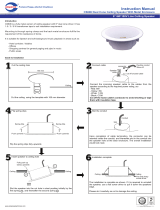
1. Introduction
4
CMS 3.0 Series Operation Manual rev 3.0.0
1. Introduction
Thank you for purchasing this Tannoy Ceiling Monitor System product. Designed for both speech and music
program material, the Tannoy CMS range provides exceptional sonic quality and long-term reliability in all ceiling-
mount applications. The CMS 3.0 DC series features new 16 ohm Dual Concentric™ drivers for improved
performance and prolonged service life.
2. Unpacking
Every Tannoy product is carefully inspected before shipment. After unpacking, please inspect your product to
ensure no damage has occurred in transit. In the unlikely event of damage, please notify your dealer and retain
all shipping materials as your dealer may require return shipment.
All CMS loudspeakers are shipped in pairs and provided with the following accessories as standard: C-ring,
tile-bridge kit, cut-out template and paint mask. A plaster (mud) ring is available as an optional accessory.
3. Safety Notices
Some regional construction codes require the use of a secondary method of securing loudspeakers in the
ceiling to provide security of a back-up support. A secondary support line should be attached from the safety
loop on the rear of the product to a source point on the ceiling. For PI models, the secondary support line
should be attached from the back of the driver chassis to a source point on the ceiling. Please consult the
relevant construction codes in your region.
When using a power driver to install the product, it is essential to use the correct torque level settings to avoid
over-tightening and damage to the ceiling material or clamps. Recommended torque setting: 1.5 Nm
Tannoy will not be held responsible for any damages caused by the improper installation of these loudspeakers.
The CMS 603 ICT LS is UL-1480, category UUMW, for use with non-DC supervised systems.
Electrical Safety Notice: To comply with the standard UL-1480, metal-clad exible conduit (BX) is required for
connection to the terminal block for proper earth grounding.
In order to comply with UL regulations, the PI backcan must always be used with the CMS PI models.
SAFETY NOTE:
In order to comply with the relevant re safety regulations (ie. BS 5839:1998), it is required that in the event of
re, that failure of the circuit to which the loudspeaker is connected does not occur before evacuation of the
building is complete. Suitable measures include:
a) use of terminal blocks (for connection to primary) with a melting point of not less than 650°C, for example
constructed from ceramic materials;
b) use of terminal blocks of a lower melting point but protected with thermal insulation;
c) use of terminal blocks such that, on melting, an open-circuit or a short-circuit does not occur.























